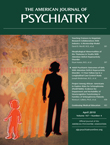Deactivation of the Parahippocampal Gyrus Preceding Auditory Hallucinations in Schizophrenia
Abstract
Objective
Activation in a network of language-related regions has been reported during auditory verbal hallucinations. It remains unclear, however, how this activation is triggered. Identifying brain regions that show significant signal changes preceding auditory hallucinations might reveal the origin of these hallucinations.
Method
Twenty-four patients with a psychotic disorder indicated the presence of auditory verbal hallucinations during 3-Tesla functional magnetic resonance imaging by squeezing a handheld balloon. A one-sample t test was performed to reveal groupwise activation during hallucinations. To enable analysis of brain activation 6 to 0 seconds preceding hallucinations, a tailored 'selective averaging' method, without any a priori assumptions concerning the hemodynamic response profile, was performed. To control for motor-related activation, 15 healthy comparison subjects squeezed a balloon at matched time intervals.
Results
Groupwise analysis during auditory verbal hallucinations revealed brain activation in bilateral (right more than left) language-related regions and bilateral motor regions. Prominent deactivation preceding these hallucinations was observed in the left parahippocampal gyrus. In addition, significant deactivation preceding hallucinations was found in the left superior temporal, right inferior frontal, and left middle frontal gyri as well as in the right insula and left cerebellum. No significant signal changes were revealed prior to the matched balloon squeezing among the comparison subjects.
Conclusion
Auditory verbal hallucinations in patients with a psychotic disorder are consistently preceded by deactivation of the parahippocampal gyrus. The parahippocampus has been hypothesized to play a central role in memory recollection, sending information from the hippocampus to the association areas. Dysfunction of this region could trigger inadequate activation of right language areas during auditory hallucinations.



